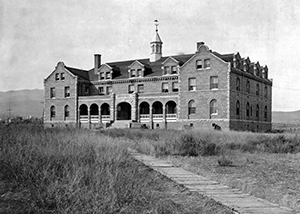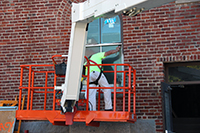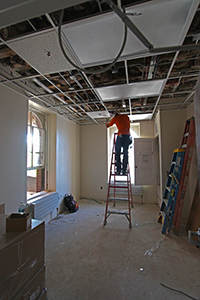Lincoln Hall, 120 years old and one of the oldest buildings on the University of Nevada, Reno campus, has undergone structural upgrades that address seismic and safety standards and interior remodeling to transform the space into much needed faculty offices.
The showcase project to protect the historic three-story brick building began in December and is on target for completion, with furniture to be moved in soon and professors moving into the iconic location by the beginning of the semester.
"As the University continues to grow - we are knocking at the door of 22,000 students, with a goal of hiring 400 new faculty members in the next six years - we must continually plan for our future while retaining our roots as the state's oldest institution of higher learning," University President Marc Johnson said. "Running in parallel with this growth, the campus will be growing with new buildings to make room for more students and more classrooms. An equally important component in our plan is the preservation of our historic buildings.
"We take sincerely the commitment to preserve the historical nature of our campus. With the Quad, Manzanita Lake and13 buildings on the National Register of Historical Places, it's a big responsibility for our institution, one that we take quite seriously."
This commitment includes about $26 million invested for renovation of several historic campus buildings, of which $8.5 million was allocated for Lincoln Hall.
"With Lincoln Hall we are preserving the historical features of the building, while gaining office space for faculty," Johnson said. "We made a commitment for Lincoln's preservation two years ago and put a plan into place. It's gratifying to see the plan coming to fruition. The Lincoln Hall restoration has been remarkable - they've done such a wonderful job you may not even notice the exterior upgrades."
Its dormers and parapets that line the rooftop, arched entryway and ornamental rock corners are all part of the "Eclectic" style of architecture popular at the time, 1895, which combined several styles of earlier architecture to form a new look. It reflected the principles of Thomas Jefferson's plan for the University of Virginia that resulted in the Reno campus's first quadrangle flanked by academic and administrative buildings and student residences starting when the campus moved in 1885.
While many influential architects of the time impacted the beautiful design of Lincoln Hall, the structural elements of the time included the masonry walls that bear the weight of the building, with little or no structural steel or reinforcement. This unreinforced masonry construction of that era is now considered to be structurally unsound in large earthquakes.
"Lincoln Hall was in critical need of a 'life safety' retrofit to ensure the safety of its occupants and those who walk near this historic building," Graham Kent, director of the Nevada Seismological Laboratory, said. "During the process of retrofit, it became clear that Lincoln Hall had no basic ability to sustain lateral shear or motion from a significant earthquake. That scenario is no longer the case as significant effort has been done to give it lateral strength, the reduction of peeling bricks and other life saving measures."
Updating campus classics
In addition to Lincoln Hall, two other buildings on the register have undergone seismic retrofit, and three more of the unreinforced masonry buildings are slated to receive seismic upgrades. They include Thompson Hall, Palmer Engineering and Manzanita Hall. The Thompson Hall project is already underway and Palmer Engineering has been vacated in preparation for the upgrade work in the near future.
Manzanita Hall, a student residence hall built in 1896, was closed in 2015. In its present condition, Manzanita Hall is likely to partially collapse during a large earthquake. Even if unoccupied, this presents a serious hazard on campus. The University is awaiting approvals for a seismic upgrade and restoration for Manzanita Hall.
Also closed as a residence hall in May 2015, Lincoln Hall - named for President Abraham Lincoln - restoration was undertaken in cooperation with the State Historical Preservation Office and a historic structures design agent who specializes in seismic, fire and safety, mechanical, plumbing, phone and data, and Americans with Disabilities Act access upgrades.
"Our local architects worked with experts in historical preservation structural engineering and architects who specialize in protecting the historically significant components of the building," John Walsh, director of Capital Improvement Projects and project manager, said. "We've retained the legacy of the building through this process - repairing and reinforcing the brick structure, replacing some of the original components lost over time. We're matching original colors and other design features, but not only that, we're making the building ADA compliant and upgrading fire systems to make the building safer for occupants."
Lincoln Hall and the other historic buildings are listed in the National Register of Historic Places as part of the University of Nevada, Reno Historic District, which was designated in 1987 and includes the 13 contributing historic buildings in the 40-acre area that reaches west from the Quad to North Virginia Street and south to East 9th Street.
The original construction on Lincoln Hall began in 1895 and opened as a men's dorm in 1896. When the building was closed in 2015, it was the longest continuously operating residence hall on a college campus in the United States, housing nearly 20,000 residents over the past 120 years
Over the years, the interior of the building underwent a number of changes, most notably in the 1950s when renovations were undertaken to update the plumbing and electrical systems, and in the process, many unique historical features of the hall were lost. The grand staircase was replaced with two flights of stairs on the west and east wings and the fireplace in the west lounge was boarded up, all of which contributed to the loss of the historical significance of the interior design.
In preparation for the historical preservation aspects of the project, designers analyzed as many as 18 layers of paint to find the original colors, analyzed photographs and documents to track the modifications over the years, studied the type of mortar used in the original construction and subsequent repairs and scoured the structure to analyze areas that needed fortification. Contractors placed more than 3,000 structural bolts, installed metal strapping and added reinforced concrete as part of the structural fortification.
As an unreinforced masonry building, or URM, Lincoln Hall was one of more than 23,000 such buildings in Nevada and 7,000 in northern Nevada faced with requiring fortification.
"This is a showcase project for URMs around the state," Kent said. "With Lincoln, other buildings on campus help make the University a more 'Resilient Campus', and as the state's economy becomes more intertwined with higher education and its research engine, it is important to have campuses that can sustain a major earthquake without closing for an unacceptable period of time. In Nevada, such an earthquake happens somewhere every decade or two on average."
{{RelatedPrograms}}
Kent said that while Nevada has a high amount of URMs, neighboring state Utah, and Salt Lake City in particular, has 150,000 or more unreinforced masonry buildings. He said that Nevada is like many other states where retrofits are few and far between, but the preservation and retrofit initiative underway at the University mirrors other major projects at campuses in the West, most notably at the University of California, Berkeley.
"The "Resilient Campus" movement - the ability to better withstand a major earthquake or other disasters - underfoot at the University can be a guiding light for Nevada as we grapple with these serious issues," Kent said. "This project and other campus retrofits should be applauded by faculty, students and residents alike."










